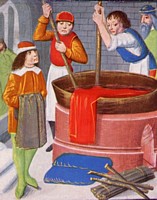The History of Magna Carta
The Magna Carta was drafted in England in 1215. According to Justin Champion, the document was originally created as a way to combat the English King John's abuses of power against his subjects; these abuses included the levying of unjust taxes, the illegal detainment of subjects, and the holding of hostages, especially women. King John's barons drafted the Magna Carta as a way to stop these abuses and prevent civil war. The 63 clauses of the Magna Carta outline rights such as the freedoms of the Church, the rights of trial by peers, and freedom from illegal detention. While it is celebrated as an immensely important historical document, the original form of the Magna Carta only last a short time before King John and the Pope disregarded the document, essentially returning to open war with his subjects.
 |
| Source: Magna Carta Trust |
Scott Alan Metzger also discusses the historical context of the Magna Carta. As he points out, in the short term, the Magna Carta failed to preserve peaceful conditions between King John and his subjects. In fact, many English subjects prepared for war and even invited a rival French prince to take the English throne; a conflict was only prevent because of King John's conveniently timed death. However, in the long term, the document proved to be an agreement for just and limited government.
Historically, the Magna Carta has proven to be a very popular document. In fact, it was widely disseminated at the time of its creation; over 40 copies were made for distribution to the regions of England. In 1225, Henry III reissued a revised Magna Carta to show his intention to rule in a benign and consensual way. The document was reissued again in 1297 and 1300. Since 1225, the document has been reissued more than 30 times by successive monarchs, usually as a sign of their good intentions to rule.
The Magna Carta has reemerged throughout history in times when peace is needed. For example, the principles set forth in the document can be seen as being embodied in the Glorious Revolution and the Bill of Rights of 1688-89 in England, in the framing of the newly created American government in the 1700s, and even in the 21st century struggle for new constitutions in Ecuador.
All in all, the Magna Carta was the first document of its kind in that it detailed written constraints on royal authority. The principles set forth in the Magna Carta have since been written into English law and have inspired governments around the world. Moreover, throughout history, the Magna Carta has come to be seen as a means for legitimizing protest against illegal or arbitrary governmental practices. In fact, the document has become a universal symbol of freedom all over the world.


